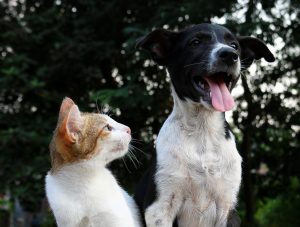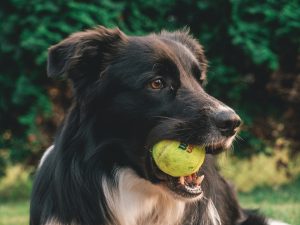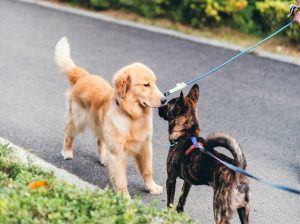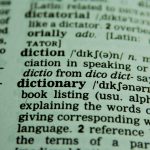Part Three Editing / Grammar Skills
Unit 9 Verb Basics in Academic Writing
Learning Objectives
- To understand what a verb is and why it is important
- To differentiate between “Be” verbs and “Do” verbs, action verbs and non-action verbs, helping verbs and main verbs, with their various uses though multiple examples and exercises
- To be aware of the twelve verb tenses and five basic verb forms
I. Pretest

The following ten sentences are about pets. Some verbs are bold-faced. Identify what type of verb each one is by selecting one of the two choices. After you finish one sentence, you will get instant feedback on your answer before the next sentence. If you make mistakes, you can retry all the questions or see all the answers at the end of the pre-test.
II. Definition of a Verb and Its Importance
Each sentence in English must have a verb. A verb expresses an action or shows a state of existence[1].
Why are verbs important? There are two reasons:
- They appear in every sentence in English.
- Errors in verbs cause serious misunderstanding[2].
In order to express ideas clearly and accurately, you need to make sure:
- You have a basic understanding of different types of verbs. This is the purpose of this unit.
- A subject and its verb must match each other. For detailed information and practice, please refer to Unit 10 Subject-Verb Agreement. (Open Unit 10 here.)
- A verb tense and its verb form must match each other. There are detailed explanations and practice in verb tenses and forms from Unit 11 through Unit 14 in this book. (Open Unit 11 Present Tenses, Unit 12 Past Tenses, Unit 13 Future Tenses, Unit 14 Mixed Tenses here.)
For detailed explanations and practice in sentence structure and punctuation, open Unit 7 here.
Exercise 1. Highlight the verbs in the following short paragraph about pet dogs. (To highlight, you position your computer curser on the verbs and right click.)
III. “Be” Verbs and “Do” Verbs
“Be” verbs: They look different depending on the subjects and the verb tenses. The most common ones are “am, is, are, was, were”. A “Be” verb is often followed by a noun, a pronoun, an adjective, a prepositional phrase, or an expression of age.
- My neighbor’s pet is a rabbit. Her name is Bonny. (followed by nouns)
- Bonny is not mine. (a pronoun)
- Bonny’s tail is short and cute. (adjectives)
- Bonny is in a cage when my neighbor is at work. (prepositional phrases)
- Bonny was two months old when I first met her. (an age)
“Do” verbs: There are many “Do” verbs: study, get, sleep, wear, have, like, think…
Their forms also change based on the subjects and the verb tenses.
- Bonny stays indoors most days.
- My neighbor prepares special food for her.
- Sometimes I see Bonnie in my neighbor’s backyard.
- I played with her yesterday.
- I hope that I can play with her again soon.
A “Be” verb is NEVER followed by the base form of a “Do” verb.
- Bonny is stay indoors most days. X
- Bonny stays indoors most days. √
- Most rabbits are stay in a cage. X
- Most rabbits stay in a cage. √
- I was meet my neighbor’s pet rabbit for the first time last week. X
- I met my neighbor’s pet rabbit for the first time last week. √
IV. Action and Non-Action Verbs
Action verbs: They show the action of the subject. All action verbs are “Do” verbs.
- In the U.S., many pet owners treat their pets as part of the family.
- Those pets get special food and even regular medical checkups.
- Some of them sleep in their owner’s bed.
- They receive toys and often wear festive[3] outfits[4] during holidays.
- Most pets enjoy their good lives.
Non-action verbs: They do not show actions; instead, they show emotional or mental states, five senses, possessions, and others. Non-action verbs are also called stative verbs or non-progressive verbs. “Be” verbs are non-action verbs in most cases.
- Pets love their owners.
- Pets understand how much they are loved.
- Some pets can weigh over fifty pounds.
- Most pets have animal doctors called vets.
- Pets are our good friends.
|
Common Non-Action Verbs |
|---|
|
Emotional/mental state:
|
|
Five senses:
|
|
Possessions:
|
|
Others:
|
Sometimes, the same verb can be both an action verb and a non-action verb, with different meanings and grammatical structures. Discuss the difference between the underlined verbs below.
- What do you think of my kitten? It seems that she is always thinking about playing hide and seek with me. (non-action, action)
- Feel the fur of my kitten. It feels so soft. (action, non-action)
- My kitten measures twelve inches in length[5]. I measure her every month to see how much she has grown. (non-action, action)
- I see some red pots on the kitten’s skin. I am taking her to her vet. We are seeing the vet at 3 pm this afternoon. (non-action, action)
Non-action verbs can be used in different verb tenses except progressive tenses, but action verbs can be used in all tenses.
- The kitten has been napping for a long time. He looks (
is looking) content[6] in his sleep. - Samantha likes (
is liking) kittens. She has (is having) two. Right now she is preparing their favorite snacks.
Exercise 2. The following sentences are about color-blindness[7] of dogs. Some verbs are bold-faced. Highlight if each bold-faced verb is an action verb or a non-action verb. The first one is an example. When you finish the exercise, you can retry or see all the answers. (To highlight, you position your computer curser on the verbs and right click.)

V. Helping Verbs and Main Verbs
Helping verbs: They are also called auxiliary verbs. These verbs “help” the main verbs to
- show verb tense
- make a negative sentence
- ask a question
- change the meaning or tone
- change the voice (from active to passive or passive to active, not addressed in this course)
Helping verbs must work with main verbs to form complete verbs. Common helping verbs include “do, does, did, have, had, had, will”.
helping verb + main verb = complete verb
- Mohamod has always wanted to get his driver’s license. (helping verb “has” + main verb “wanted”)
- He has prepared for this driver’s test for several months. (helping verb “has” + main verb “prepared”)
- He does not want to carpool with his friend every day. (helping verb “does” + main verb “want”)
- He hopes that he will pass the road test. (helping verb “will” + main verb “pass”)
- Should he celebrate if he passes? (helping verb “should” + main verb “celebrate”)

Modals: Modals are a special type of helping verbs. They mainly show ability, possibility, obligation, advice, and many others. They are followed by the base form of the main verb.
- Every driver in the U.S. must have a driver’s license. (modal/helping verb “must” + main verb “have”)
- Should he or she buy car insurance, too? (modal/helping verb “should” + main verb “buy”)
- Maintaining a car can be expensive. (modal/helping verb “can” + main verb “be”)
- Life could become difficult without a car. (modal/helping verb “could” + main verb “become”)
For detailed explanations and examples of modals, please refer to Unit 15 Modals. (Open Unit 15 here.)
Exercise 3. The following is a brief account of Jose and his car. Type the helping verb in each sentence in the appropriate boxe. The first sentence is an example. When you finish the entire exercise, you can retry or see all the answers.
VI. Twelve Verb Tenses
While verbs show actions or states of being, verb tenses indicate the time of those actions or states of being:
- in the past, in the present, in the future, or from past to present
- happened just once, happened repeatedly, or is still happening.
There are twelve tenses in English:
|
|
PAST |
PRESENT |
FUTURE |
|---|---|---|---|
|
SIMPLE |
I studied. You studied. He studied. They studied. |
I study. You study. He studies. They study. |
I will study. I am going to study. You will study. You are going to study. He will study. He is going to study. They will study. They are going to study. |
|
PROGRESSIVE |
I was studying. You were studying. He was studying. They were studying. |
I am studying. You are studying He is studying. They are studying. |
I will be studying. I am going to be studying. You will study. You are going to study. He will be studying. He is going to be studying. They will be studying. They are going to be studying. |
|
PERFECT
|
I had studied. You had studied. He had studied. They had studied. |
I have studied. You have studied. He has studied. They have studied. |
I will have studied. You will have studied. He will have studied. They will have studied. |
|
PERFECT PROGRESSIVE |
I had been studying. You had been studying. He had been studying. They had been studying. |
I have been studying. You have been studying. He has been studying. They have been studying. |
I will have been studying. You will have been studying. He will have been studying. They will have been studying. |
In this course, you will be focusing on using eight of the above tenses in writing: simple present, present progressive, present perfect, present perfect progressive, simple past, past progressive, past perfect, and simple future tenses. You will learn the rest of the tenses in future courses.
VII. Five Basic Verb Forms
In the above chart, the verb “study” appears in different forms – study, studies, am studying, had been studying, will be studying, and some others. These are called verb forms. Verbs have five basic forms:
|
BASE |
PRESENT |
PRESENT PARTICIPLE |
PAST |
PAST PARTICIPLE |
|---|---|---|---|---|
|
Be
|
am, is, are |
being |
was, were |
been |
|
Do |
do, does |
doing |
did |
done
|
|
Have |
have, has
|
having |
had |
had |
|
Study |
study, studies
|
studying |
studied |
studied |
|
Move |
move, moves
|
moving |
moved |
moved |
|
Speak
|
speak, speaks |
speaking |
spoke |
spoken |
Always remember that a verb tense and its verb forms must match each other. There are detailed explanations and practice in verb tenses and forms from Unit 11 through Unit 14 in this book. (Open Unit 11 Present Tenses, Unit 12 Past Tenses, Unit 13 Future Tenses, Unit 14 Mixed Tenses here.)
VIII. Unit Review Practice
Exercise 4. The following paragraph about leashing the dog is from a previous unit. Highlight “Be” for “Be verbs” and “Do” for “Do verbs”. The first one is an example. When you finish the exercise, you can retry or see all the answers. (To highlight, you position your computer curser on the verbs and right click.)

Exercise 5. The following is a story about two puppies in love. Some verbs are bold-faced. Select what the type of verb each one is. You will get instant feedback after each sentence. If you make a mistake, you may also retry or see the answer.

Exercise 6. Take a paragraph you have written in this course. Exchange it with your partner’s.
In your partner’s paragraph,
- single underline all the “Be” verbs.
- double underline all the helping verbs.
- circle all the non-action verbs.
When you finish, return the paragraph to your partner. Discuss if you agree with each other on all the verbs.
NSNT Practice

Go to The NSNT Free Writing Approach and Additional Weekly Prompts for Writing in Appendix A. (Open Appendix A here.) Choose two topics to write a paragraph each. You may start with the NSNT approach and then rewrite it. Pay attention to the use of verbs. Be mindful of the verbs you are using: Are they main verbs or helping verbs? Action verbs or non-action verbs? “Be” verbs or “do” verbs? You are encouraged to share your writing with your partner and help each other improve.
Vocabulary Review

The words here have appeared in this unit. The best way to learn them is to guess the meaning of each word from the context. Then hover your computer mouse over the number beside each word to check its meaning and part of speech. These words are also listed in the footnote area at the end of each unit.
Here, you can use the flashcards below to review these words.
Summary
- A verb shows an action or a state of being and usually comes after the subject in a sentence.
- “Be” verbs include “am, is, are, was, were” and some others.
- There are many “Do” verbs such as “swim, study, eat, drive”.
- A “Be” verb is NEVER followed by the base form of a “Do” verb.
- An action verb shows the action of the subject.
- A non-action verb shows the state, condition, or possession of the subject. A non-action verb cannot be used in a progressive verb tense.
- Some verbs can be both action and non-action verbs, with a different meaning.
- A helping verb must be accompanied by a main verb in a sentence.
- There are twelve verb tenses and five basic verb forms. Each verb tense has its own verb forms. Verb tenses and verb forms must match each other in sentences.
Media Attributions
- a cat and a dog © Photo by Anusha Barwa on Unsplash
- a black dog with a yellow tennis ball in mouth © Photo by Tadeusz Lakota on Unsplash
- two people in a car © Photo by Orkun Azap on Unsplash
- two dogs on leash © Photo by Bundo Kim on Unsplash
- a dog swimming © Photo by Marcia Soligo on Unsplash
- a pen writing in a notebook © Photo by Aaron Burden on Unsplash
- a page in a dictionary © Pixabay
- existence: noun, being there, being this way ↵
- misunderstanding: noun, understand something in the wrong way ↵
- festive: adjective, joyful, about holidays or festivals ↵
- outfit: noun, clothing ↵
- length: noun, the noun form of the adjective "long" ↵
- content: adjective, happy and satisfied ↵
- color-blindness: noun, not able to see the differences in colors ↵

